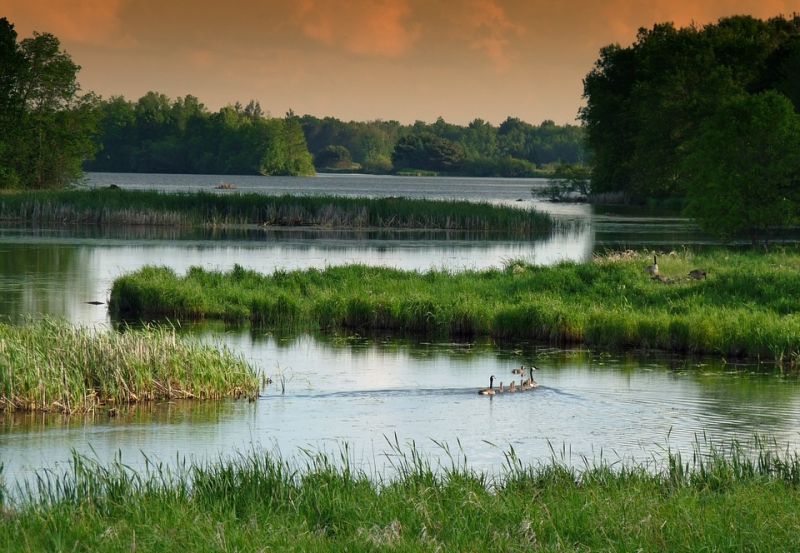Protecting Wetlands from Underground Mining Impacts
Published on by Water Network Research, Official research team of The Water Network in Academic
UNSW Engineers want to learn more about the impact of coal mining on wetlands - before and after mining occurs.
By Cecilia Duong, The University of New South Wales

Representative image source: Pixabay, labeled for reuse
What happens to a swamp (wetland) when you dig a longwall coal mine beneath it? The evidence suggests that on many occasions the water disappears and the wetland can dry up, but until now there has been a hole in the research about the processes that contribute to this. It is into this hole that Katarina David has jumped.
Dr Katarina David says the team initiated the research because they were deeply concerned about a series of incidents in the Southern Highlands of NSW where longwall mining was seemingly causing big problems with the water table, creeks and wetlands. She says that although research teams were mobilised to monitor and try to save the wetlands after the problems started, what was missing was information about the baseline condition of a wetland before the mine went in.
“I became really interested in improving our ability to predict the hydrological response of a swamp to natural or human influences by gathering information about how the groundwater behaves before any changes occur,” says David, a Lecturer in the School of Minerals and Energy Resources Engineering at UNSW.
Assembling a top-class research team (that includes Professor Wendy Timms, formally in UNSW Mining Engineering and now at Deakin University, Dr Cath Hughes and Dr Jagoda Crawford from ANSTO (Australia’s Nuclear Science and Technology Organisation), Dayna McGeeney formally in UNSW’s Water Research Laboratory and Professor Andy Baker from UNSW Biological, Earth and Environmental Sciences), David says the project began in 2016 as part of her post-doctoral research. The team chose an area where a longwall coal mine was planned, and took a series of samples from three naturally intact wetland systems before any mining activity started.
“We decided to apply the stable isotope direct vapour equilibration method to characterise the wetland in order to define how factors, including evaporation, rainfall and groundwater, contribute to the overall swamp water balance,” she explains.
“This method is particularly useful because it enables us to obtain high frequency water samples from rocks and soils. We pack the samples into bags, then inflate the bags with dry air and allow the samples to equilibrate. This means we allow the vapour to come out of the sample and measure the ratio of stable isotopes. The comparison with isotopic ratio of the standard gives us valuable information about the source of water in the rock or sediment, and what sort of processes are going on.”
According to David this method is an improvement on other techniques because it can give specific information about past temperature, condensation and evaporation processes, and can also be used to see whether the groundwater is sourced from rainfall or from mixing with other waters. Another bonus is that this can be done without drilling holes. This nonintrusive method is ideal for working in a protected wetland area.
Their results, published in 2018 in the Journal of Hydrology and Earth System Sciences, clearly showed that groundwater is a vital contributor to the swamps. “Groundwater, compared to surface water, is a slow, continuous process, and we found that it is a really important factor for wetlands to maintain their water balance,” says David.
“As a baseline, this research describes what the situation is now, so that when the mining operation approaches these swamps, and we repeat the research, we will be able to find out how the processes change.”
David hopes her research will result in a much more careful consideration of wetlands in mining and other underground engineering approvals processes, but says it will also be useful for scientists and ecologists examining other aspects of wetland ecosystems.
“I’m passionate about this topic because wetland systems, once lost, are not really something we can bring back. To keep and maintain these systems is really important and I see this research becoming the first step in a process that is usually back to front. Having researchers come in at the end once a wetland is dry is too late,” she says.
“My focus is to prevent this type of loss happening in the first place and I’m so grateful to all my co-authors who gave their time to this research. I look forward to continuing it in the future.”
Source: UNSW
Media
Taxonomy
- Industrial Water Treatment
- Industrial Water Managment
- Hydrology
- Wetlands
- Mining Development
- Constructed Wetlands
- Mine Water Management
- Hydrology
- Hydrologist
- Hydrological Modelling
- Clean Coal
- Clean Coal